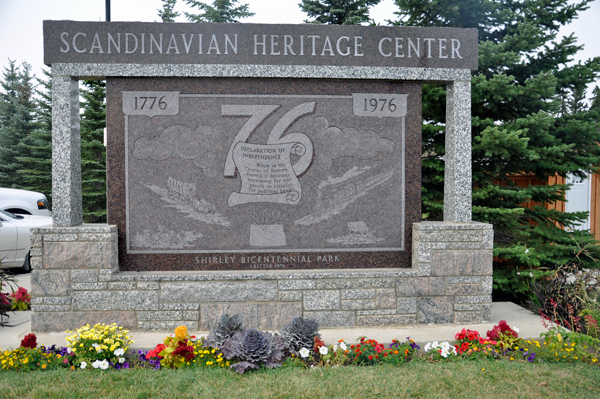 |
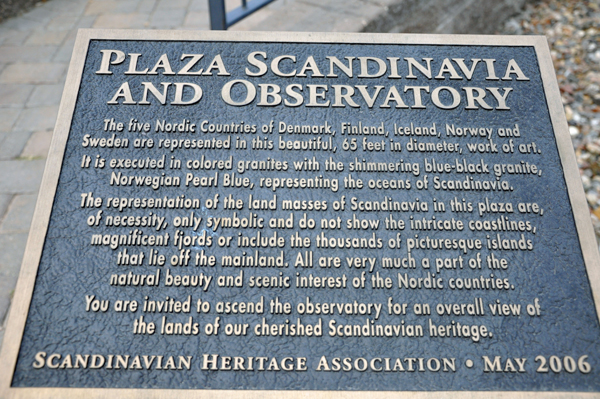 |
Below: Lee Duquette had fun
spinning the 48-inch diameter floating, spinning, marble globe fountain
in the observatory section, as he explored its contents. |
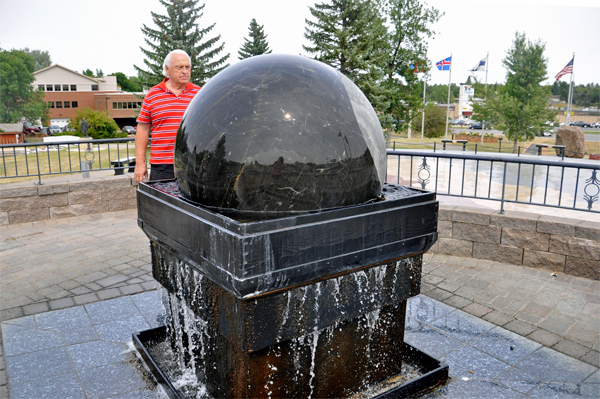 |
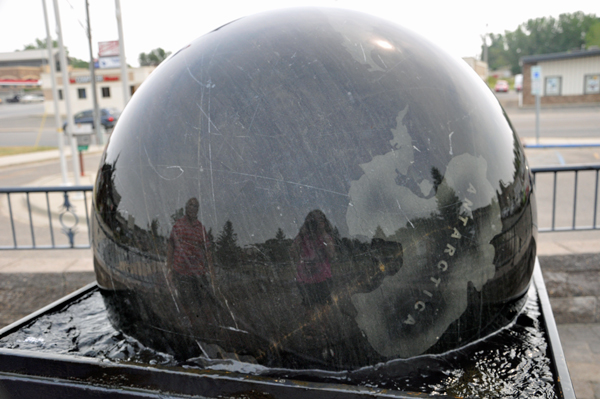 |
Below
- Plaza Scandinavia: The map of the five Nordic countries:
Denmark, Finland, Iceland, Norway, and Sweden, was completed in summer
2011. This beautiful work of art is 75-feet in diameter and executed
in different colored granite tiles with a background of Norwegian Blue
Pearl Granite. The shimmering blue-black granite, (representing the
ocean of Scandinavia), creates a dramatic vision and a most unique structure
for the park.
The map plaza with its position at the entrance to the park is a reception
and disembarkation area for visitors. This actual map representation
of the Scandinavian countries also serves as an educational tool for
visitors to the park. Integrated into the map plaza is a bronze compass
and eight strategically positioned observation/rest benches of granite.
Granite was selected for this project for its long-term durability
and is second only to diamonds in its hardness.
The bronze compass inset into the granite also serves as the name
place for this monumental map of Scandinavia. The names of the countries
and their capital cities are also on bronze plaques which are inset
on the map at the capitals' locations.
Along with the other structures in the park, it serves to commemorate
and honor the Scandinavian immigrants, who left their homes across the
ocean and endured many hardships to establish their new homes in North
America. Their contributions to life in the New World have been many. |
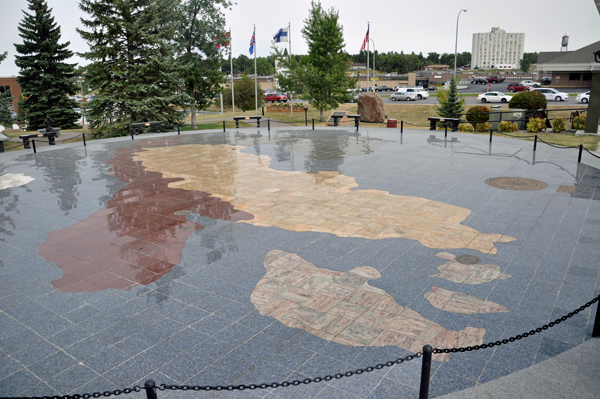 |
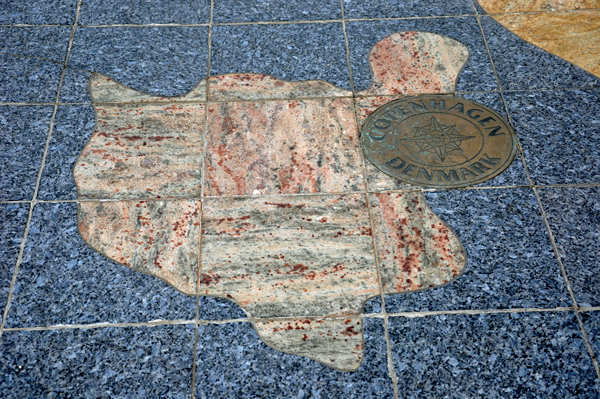 |
Below: E.D.
Schmit's Rock of Ages / 1886-1986 Minot Ward County Centennial Time
Capsule |
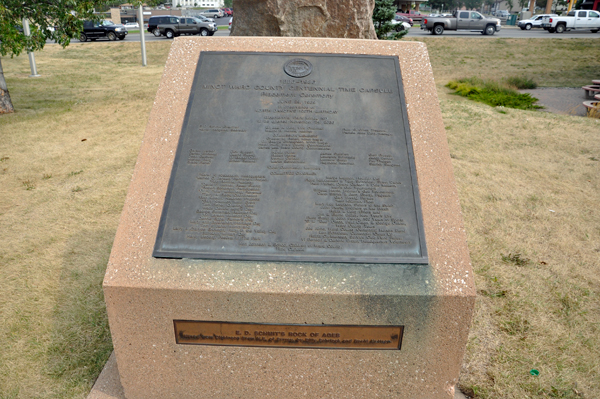 |
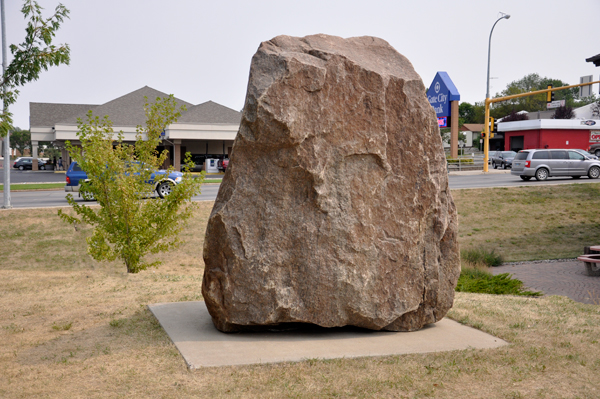 |
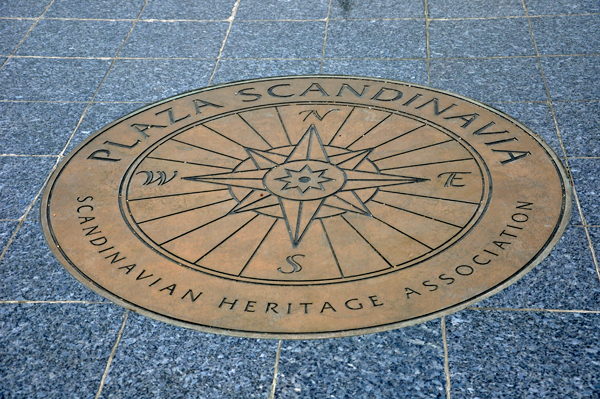 |
Below: Another time capsule |
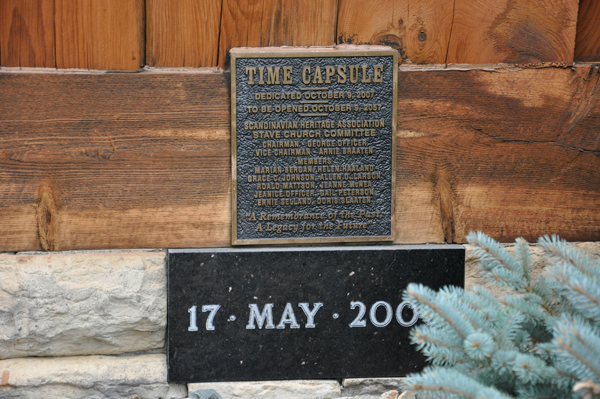 |
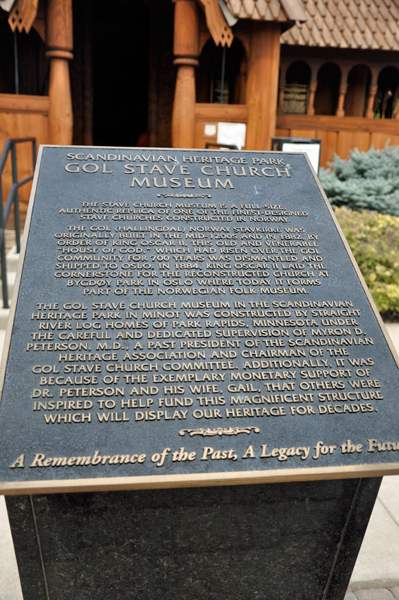 |
Below:
The Gol Stave Church Museum is a full-size replica of
the Gol Stave Church, which was moved from Gol, Hallingdal to the Folk
Museum in Bygdoy Park in Oslo, Norway about 100 years ago. It now has
a place of honor in the Heritage Park.
This replica building is 60-feet by 45-feet at the base and about
60-feet-high. It is dedicated to the pioneer immigrants who uprooted
themselves from Scandinavia to make new homes in North America.
Noted wood carvers Philip Odden and Elsa Bigton of Barronet, Wisconsin
have completed the intricately-carved front and side portals and doors.
Some 700-800-year-old stave churches in Norway still stand. |
 |
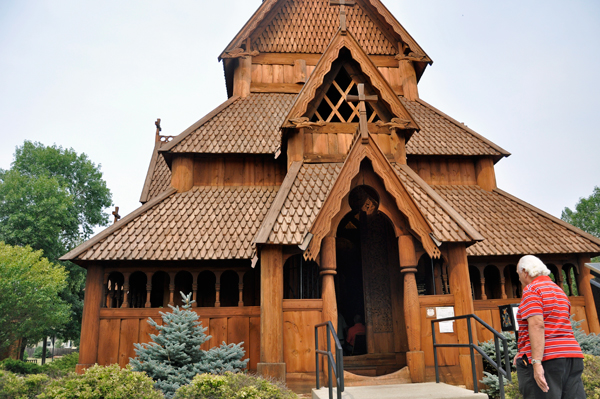 |
Inside the church, the corner
posts are essential. They are often accentuated, and are heavier and
more richly decorated than the other structural elements. They represent
the four gospels whose teachings are the supporting foundation of all
Christianity." The beams upon which the columns rest "signify God's
apostles, the foundation of all Christianity." The floor boards represent
"the humble men who bow in honour; the more they are exposed to the
trampling feet of the congregation, the more support they provide."
The roof surface which protects the church from snow and inclement
weather "represents the men...whose prayers protect Christianity from
temptation."
Above excerpts above from Norway's Stave Churches by Eva
Valebrokk and Thomas Thiis-Evensen |
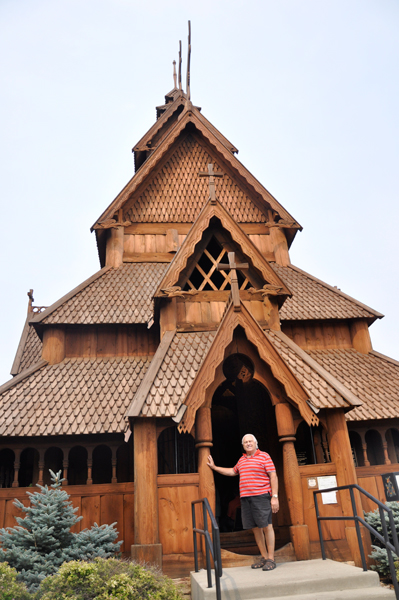 |
Below:
Danish Windmill: In 1928, the windmill was built by Carl Olson
in Powers Lake and was used to supply water and to grind wheat for the
family. It was donated to Roosevelt Park in the mid-1960s by Olson's
family. A favorite spot for visitors and photographers, the forces of
man and nature took their toll on the windmill and it was taken down
for repairs. A volunteer effort, led by Scandinavian Heritage board
member Lawrence Thompson, provided a new, more prominent rock and concrete
base for the Windmill's present location. It was dedicated, along with
the Flag Display (shown at the bottom of this page), on October 12,
1992. |
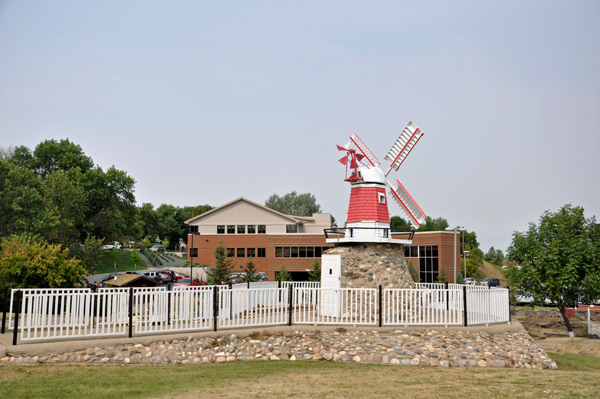 |
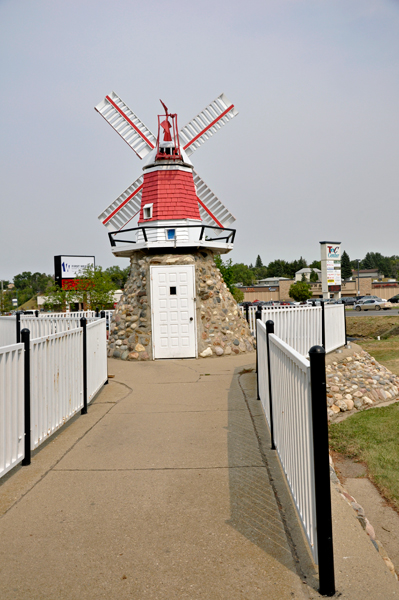 |
Below:
The waterfall was dedicated on June 29, 2000, but was under repair on
the date the two RV Gypsies were at the Scandinavian Heritage Center.
Water plays a large part in the lives of Scandinavians and the cascading
waterfall and rippling stream that normally flows down to the serene
ponds are pleasant reminders. (Previously about 600 gallons per minute
of water flowed over the waterfall in the summer.) |
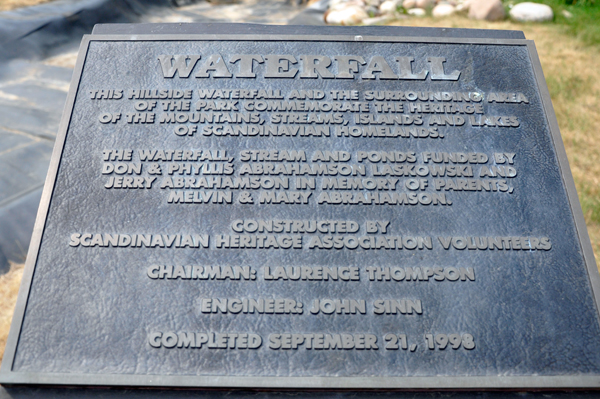 |
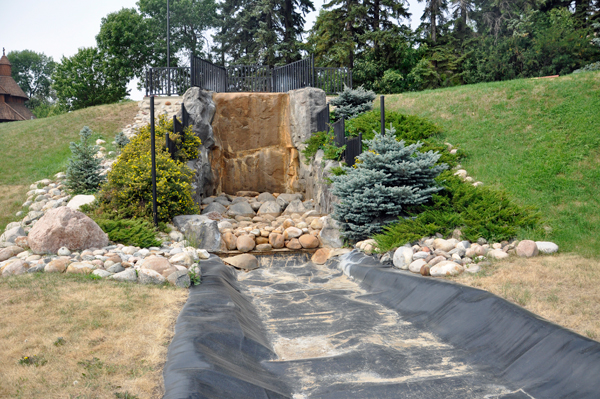 |
Below:
The statue of Icelandic explorer, Leif Erikson, was
unveiled in the Scandinavian Heritage Park on October 12, 1993. The
fine detail of this bronze statue is a tribute to the skill of the sculptor,
Arlen Evenson of Boundary Lake, north of Bottineau, N.D. According to
the Vinlanda Saga of Iceland, "Leif the Lucky" was the first man of
European stock to step ashore in America in about the year 1000.
The Icelandic Heritage Society sponsored this magnificent addition
to the park.
Leif Erikson is a fitting symbol for all North Americans whose heritage
lies in the Nordic countries beyond our shores. According to Saga tradition,
his father, Erik the Red, was Norwegian. Leif was born in Eiriksstadir,
Iceland, lived and farmed at Brattahlid, Greenland, and served one winter
under the Norwegian king in Trondheim. Leif, Leiv, or Leifur? Erikson
or Eirikssen? Different spellings reflect his popularity with all the
Scandinavian groups. |
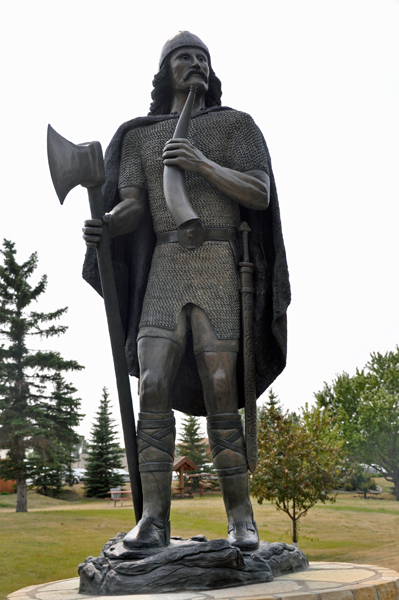 |
Below:
Hans Christian Andersen nearly comes to life in the
park's newest statue, which was sponsored by the Danish Society. Shari
Hamilton of Westhope was the sculptor of this magnificent work of art.
It was dedicated on October 5, 2004 during and unveiling ceremony attended
by representatives of the five Scandinavian countries.
The sculpture was funded by Lynn and Marilyn Odlund of Mitchell, SD
in honor of Mr. Odlund's mother, Alice Nelson-Odlund, an elementary
teacher who encouraged her students to read, using the Andersen fairy
tales to spark their interest.
Hans Christian Andersen was most famous for his fairy tales even though
he wrote novels, poems, plays and travel articles. One of the things
his works taught was that beauty comes from within. |
|
|
Below:
A large 30-foot tall Dala (dawla) horse, which is the most recognized
Swedish symbol in the world, was dedicated by the Swedish Heritage Association
on October 10, 2000.
These brightly colored horses have been carved in various sizes by
Swedish craftsmen and take their name from the province of Dalarna where
is has been a popular form of domestic art since the 1840s. Historical
accounts vary in giving credit to woodsmen and to soldiers for originating
the craft. It is certain that long autumn and winter evenings with little
to do, coupled with the availability of wood scraps from the furniture-making
trade of the area, fostered the development of the Dala Horse.
The first Dala Horses were plain wood, created as toys for children.
A hundred years later, they took on their familiar bright colors and
kurbit (flower-patterned) saddle and harness designs. |
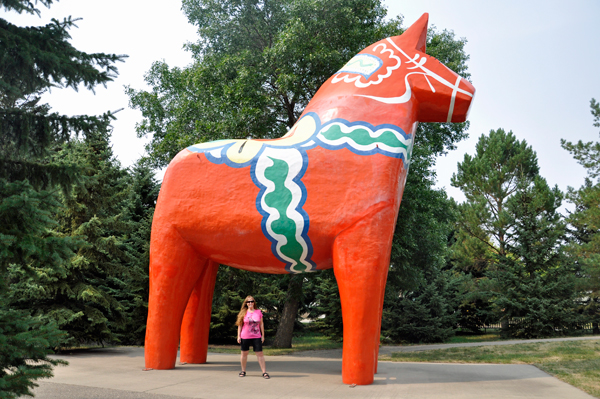 |
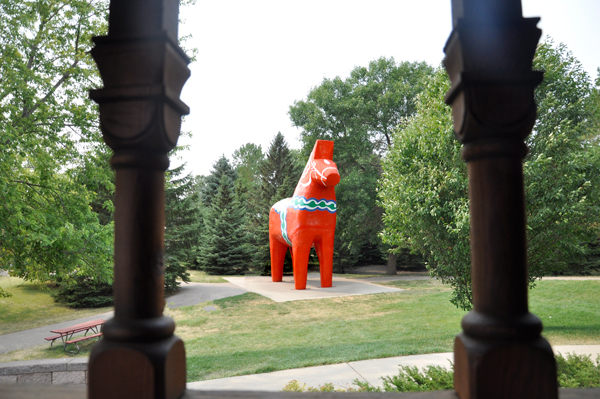 |
Below: The Dala Horse in North Dakota,
USA |
Below: FLASHBACK to June
22, 2008 - Karen Duquette on a Dala Horse in a playground in STOCKHOLM,
SWEDEN |
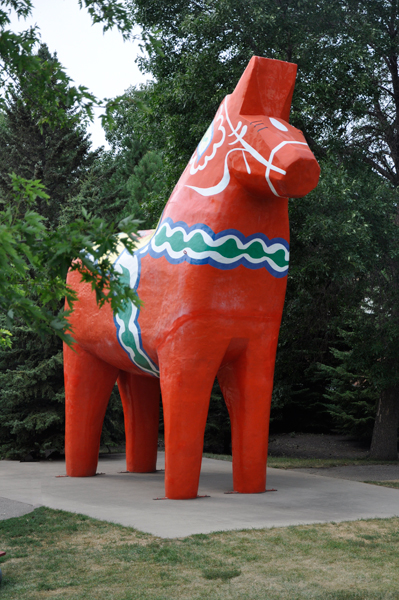 |
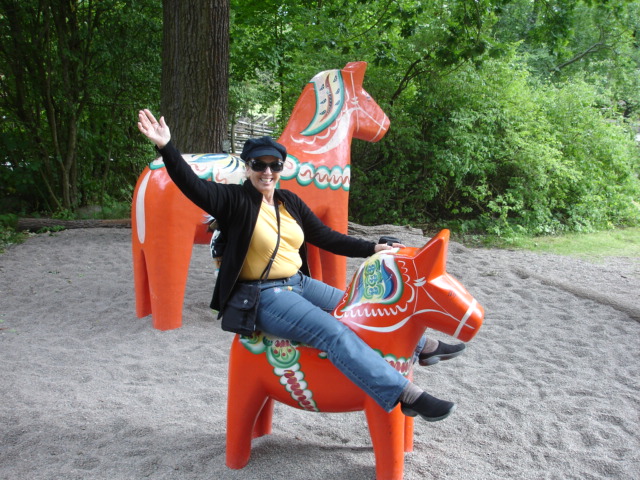 |
|
|
Below:
The Sigdal House is a 230-year-old house from the Vatnas
area of Sigdal, Norway, the oldest house in North Dakota. It was selected
to be representative of a typical house from old-time Norway,
It was purchased by the Scandinavian Heritage Association from Thorvald
Watnas and restored with museum standards by Arne Svarstad and crew.
The house was then dismantled with each log being carefully numbered
for accurate reassembling. Even the old moss which was used to seal
in between the logs was saved along with the rocks that formed the fireplace.
The entire house was carefully packed in an overseas container and shipped
to Minot, and Svarstad and his helpers reassembled the house in the
park.
The decorations on the doors inside the house as they were painted
about 1800 by the famous painter from Sigdal, Guldbrand Larsen Foss
and were restored by artist Hans Wold prior to the house coming to America.
The completed house was dedicated on October 15, 1991
as a tangible reminder of the important part our forebears have played
in the lives of all of us. |
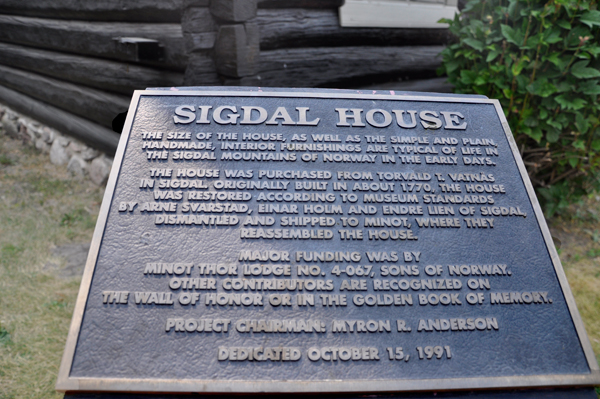 |
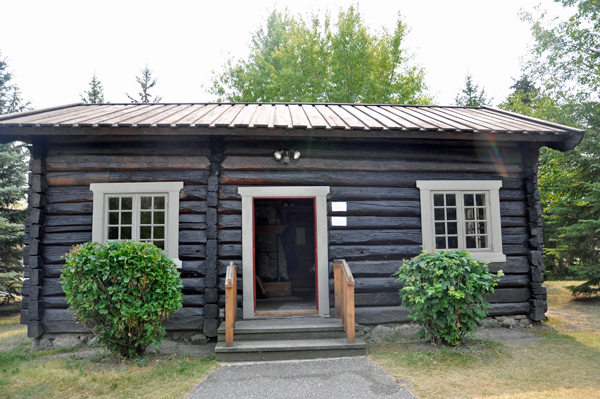 |
Below: Karen Duquette found
a new friend inside the Sigdal House. |
 |
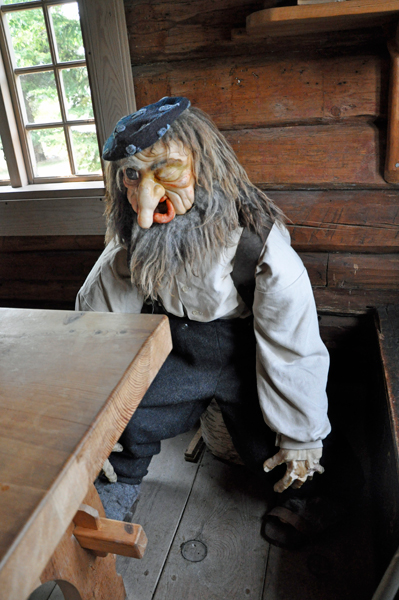 |
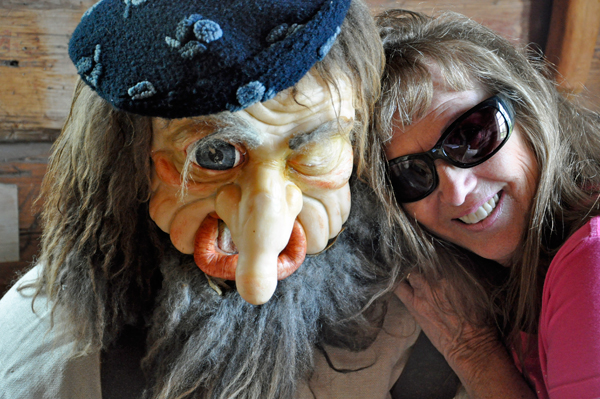 |
Below:
This stabbur is a replica of a storehouse from a farm
near Telemark, Norway. The original was built about 1775. This replica
was constructed in Norway. It was then disassembled and shipped to Minot
where it was reconstructed in 1990.
Trunks with clothing and valuables were stored on the upper floor. Food
and commodities were stored on the ground floor. Water and rodents were
the biggest enemies in a storehouse. Stilts raised the floor level,
the wooden steps did not come into contact with the building to reduce
the possibility of rodent infestation and meat/cheese was hung from
the ceiling.
According to the Norwegian folklore each farmstead has a Christmas gnome
living in their stabbur. The Christmas gnome brings gifts for well-behaved
children. But if the gnomes are not well-looked after, they can play
tricks on people. Some people put out a bowl of rice porridge sprinkled
with sugar and cinnamon to keep their barn gnome happy, much like children
today leave out cookies for Santa. |
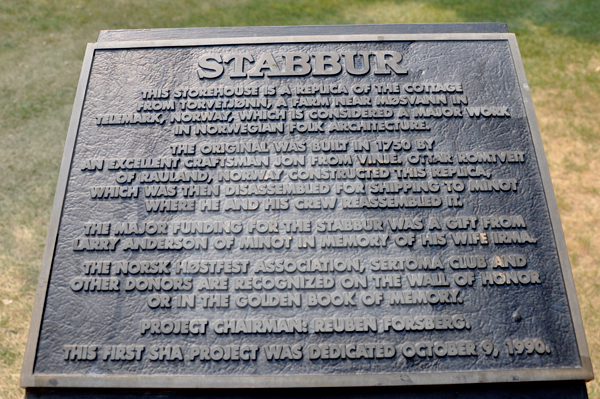 |
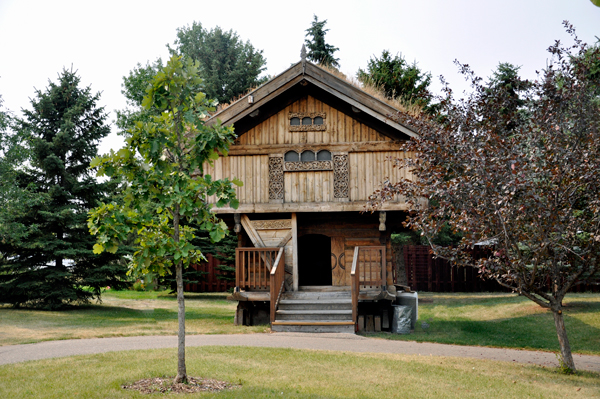 |
Below:
This Finnish sauna was completed in 1997 when FinnFest
USA held its annual national celebration in Minot. Typically, a sauna
consists of a dressing room, wooden benches and a stove of hot, glowing
stones heating the room to 190 to 280 degrees.
Sprinkling water on the stones makes the sauna steamier. Some bathers
beat themselves with wet, leafy birch twigs to stimulate circulation.
Following a hot sauna, the bathers jump into the nearest lake or swimming
pool and then repeat the process. Saunas for men and women are usually
separate.
Inviting guests for a sauna is as common as inviting
them for a meal.
In America, saunas, always known to those of Finnish
descent, acquired much wider popularity when one was installed at the
1960 Winter Olympics at Squaw Valley, California. President John F.
Kennedy built one at the White House
Finland has 4,000,000 people and 5,000,000 private saunas! |
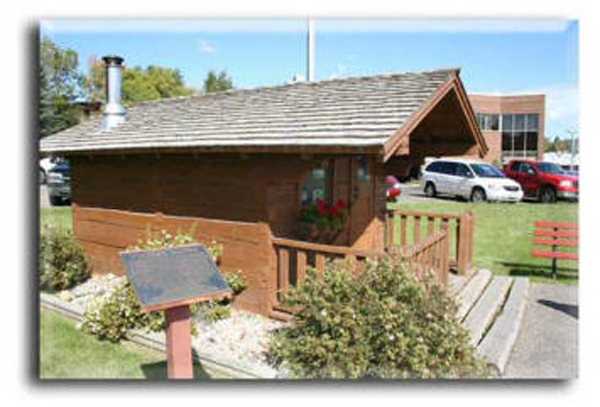 |
Below:
A bronze statue of Norwegian-born Casper Oimoen, who was a long-time
Minot resident, stands tall in the park. Oimoen was widely-acclaimed
across the continent for his graceful ski-jumping skill.
He was a member of the 1932 U.S. Olympic Ski Team and
captained the team for the 1936 Winter Olympics. The 1931 official Olympic
selection report stated: "Casper Oimen...is the best skier in the United
States and because of his outstanding performances this season has been
ranked number one on the team and the honor of being team captain."
Casper was the featured jumper at the 1933 Chicago World's Fair tournament.
A Chicago newspaper story said, "...This daring fellow
has won more titles...than any other skier." In 1963, he was inducted
into the U.S. Skiing Hall of Fame and credited with initiating the forward
lean to ski jumping in America. |
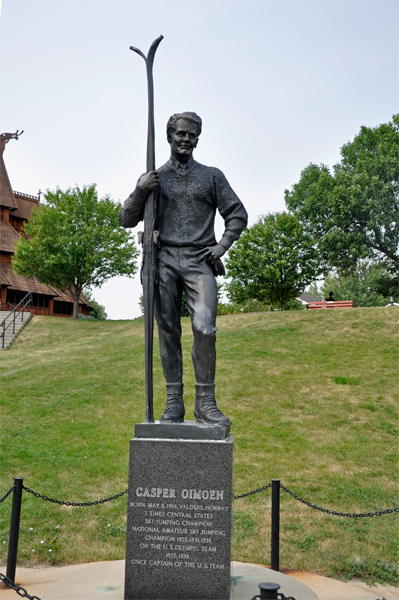 |
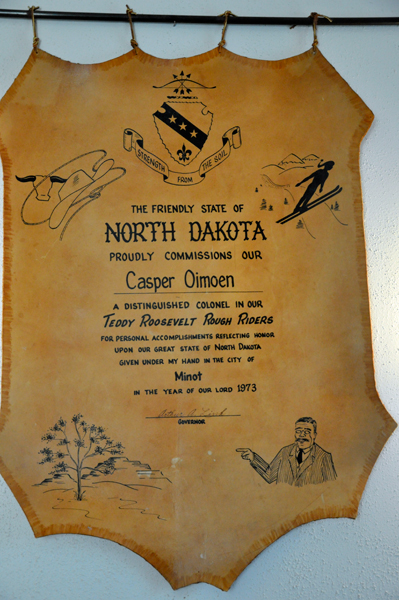 |
Below:
Sondre Norheim statue: Almost forgotten after his death
in 1897, Sondre Norheim, the father of modern skiing, has been immortalized,
not only with a marker on his grave at the Norway Lutheran Church south
of Denbigh, but with a statue in the Scandinavian Heritage Park.
He brought the joy of skiing to the world and played a crucial role
as skiing during the late 19th century changed from utility into enjoyment
and sports. Norheim was the acrobatic master of the slopes - a man whose
traces in the snow will always be visible.
Friends in Skien, Minot's sister city in Norway, raised half of the
funds for the statue which was also sponsored by Norsk Hostfest Association
and dedicated during the 1987 Hostfest.
A duplicate statue of Norheim was unveiled on January
16, 1988 in Morgedal, Norheim's birthplace in Norway. Norheim is credited
in Norway and elsewhere with making the Telemark area The "Cradle of
Skiing."
(Read about The Sondre Norheim Eternal Flame below the
statue, and see the photo of it.) |
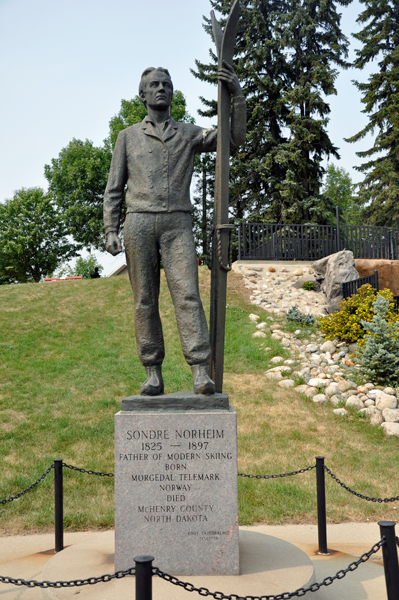 |
Below:
Lars Berge Haugann of Morgedal, Norway, lit the Sondre Norheim
Eternal Flame on December 4, 1993. A flame from the fireplace of Norheim's
birthplace in Norway was transported to Minot by North Dakota Governor
Edward Schafer on a Norsk Hostfest sponsored trip. Five aluminum skis,
symbolic of the five Scandinavian countries, support a World globe which
represents the many contributions to the sport of skiing that Sondre
Norheim gave the World. The monument was designed by Minot artist Sheldon
Larson. |
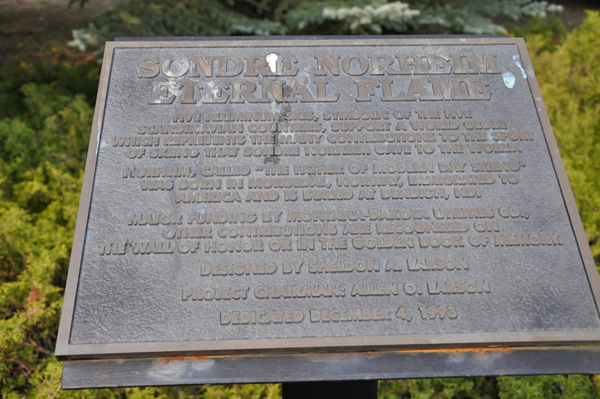 |
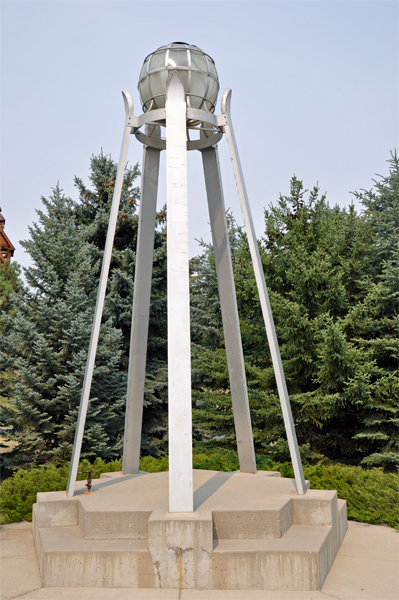 |
Below:
International Flag Display: It was a stirring occasion
on Tuesday, October 12, 1992 when the Flag Display was dedicated. Ambassadors
and many other diplomats from the five Scandinavian countries were present
to pay tribute to this unique park, situated near the Geographical Center
of North America.
The national anthems were proudly sung as the flags of the five Scandinavian
countries, Canada and the United States were raised to the top of their
30-foot-high aluminum poles. The flags fly the year around and are illuminated
at night. The following descriptions are helpful in identifying the
flags of these Nordic countries:
Denmark - A white cross on a red field is the simple
design of the Danish national flag, known as the Dannebrog (the Spirit
of Denmark), may be the oldest national flag in continuous use.
Finland - It has a light blue Scandinavian cross
on a white field, symbolizing Finland's blue lakes and white snow.
Iceland - The design of the Icelandic flag identifies
it as one of the Scandinavian groups with a red cross bordered in white
on a dark blue field.
Norway - The flag's design is based on the Dannebrog
- the Danish flag. The Norwegians added the blue cross to the red and
white Dannebrog as a symbol of freedom.
Sweden - It is a golden yellow Scandinavian cross
on a blue field derived from the ancient state coat of arms dating from
1364, which bears three golden yellow crowns on a blue field. |
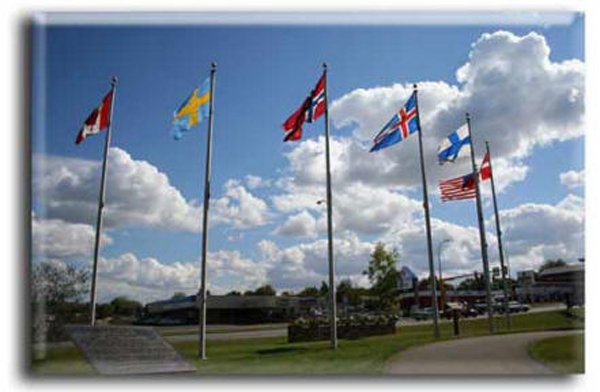 |
Below: Inside the Museum |
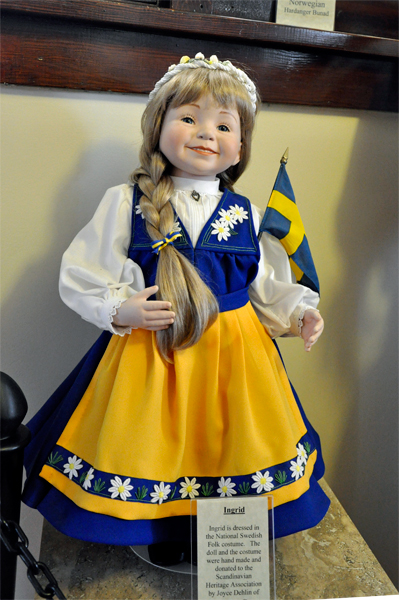 |
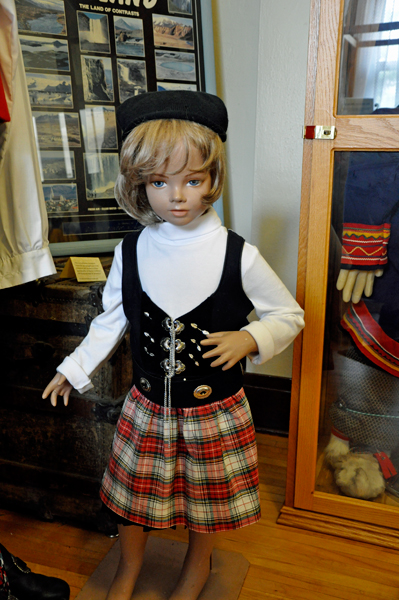 |
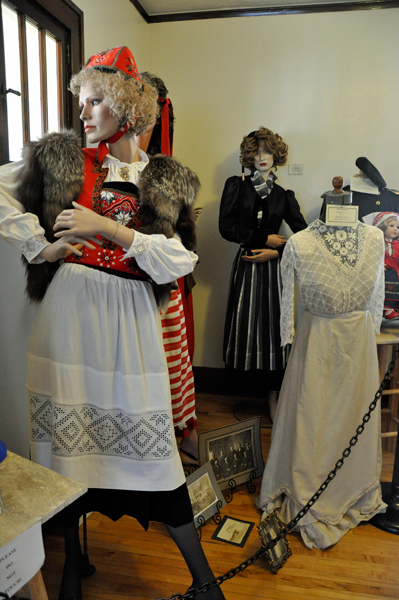 |
Below: Inside the Gift Shop
- A dude with his hand in the wrong place! |
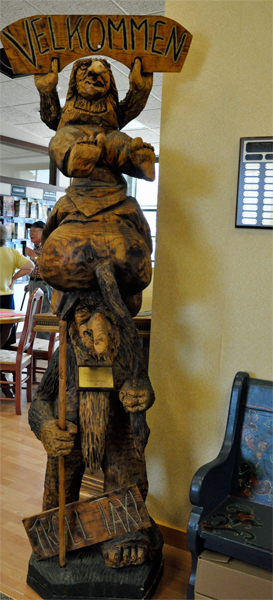 |
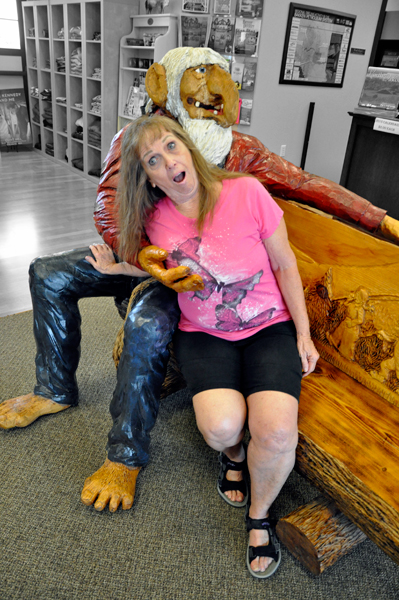 |



















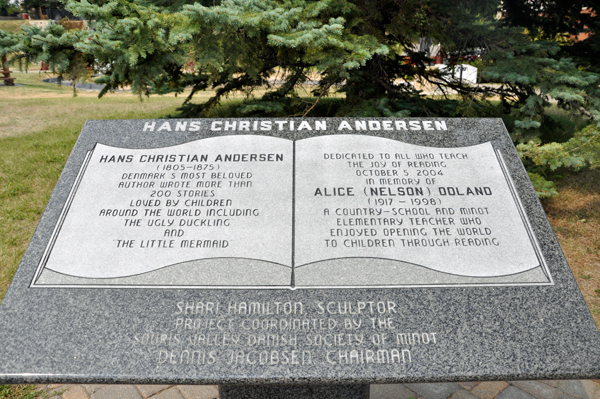
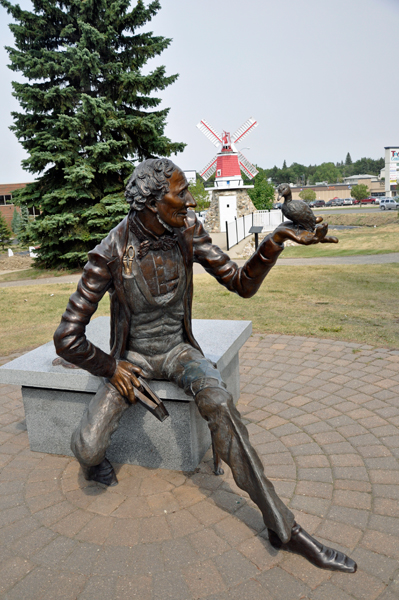




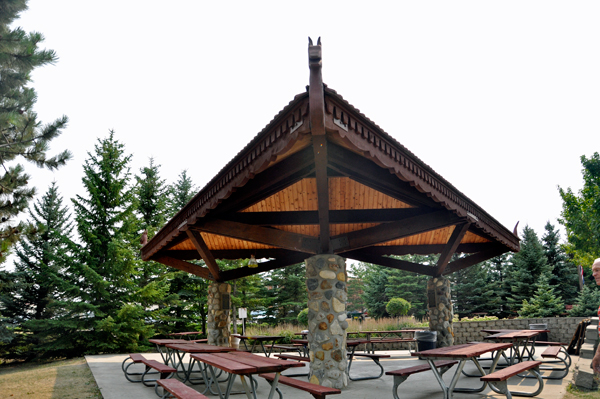











































 If
you have already seen all of the North Dakota sections,
If
you have already seen all of the North Dakota sections, 
